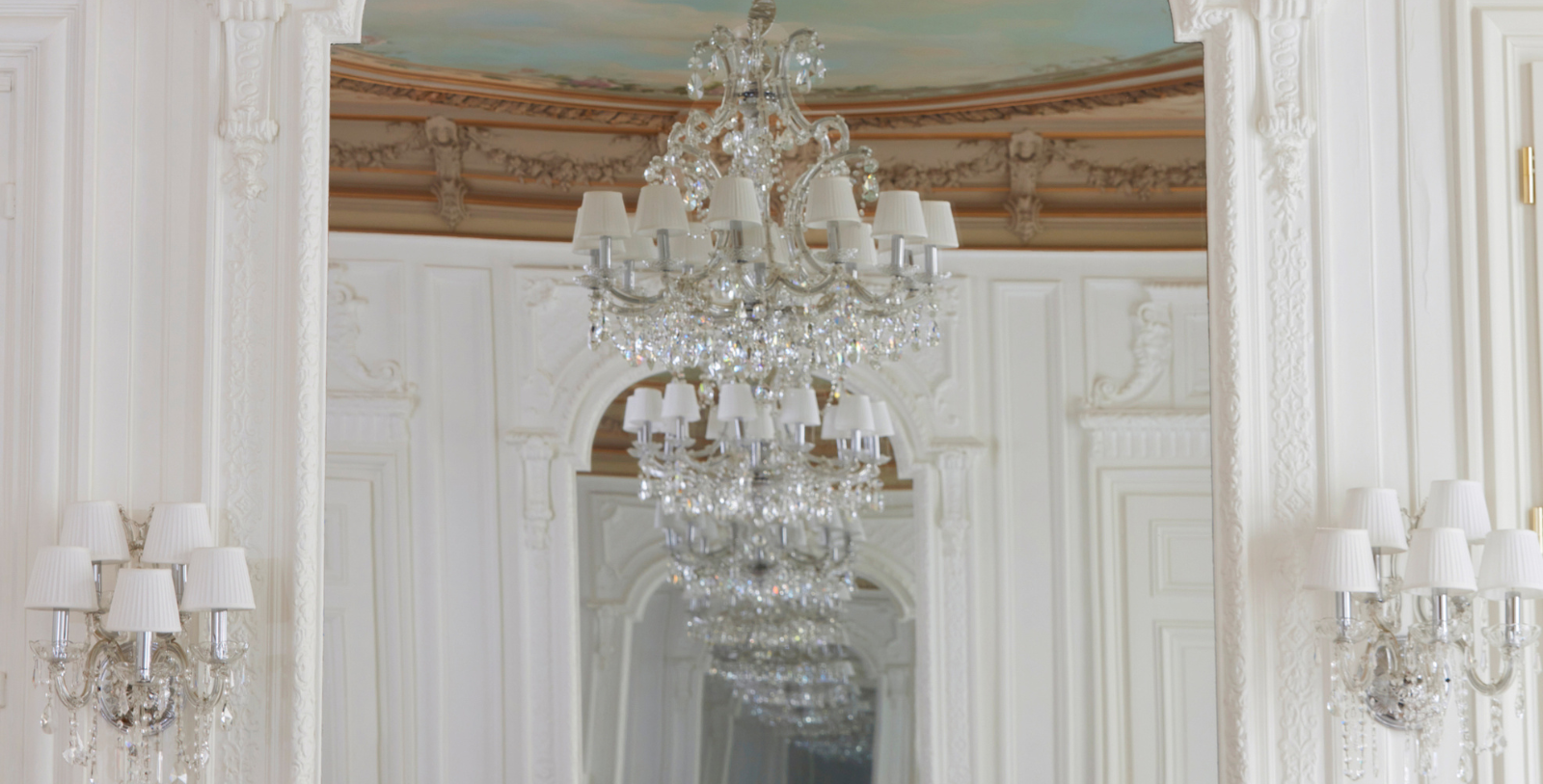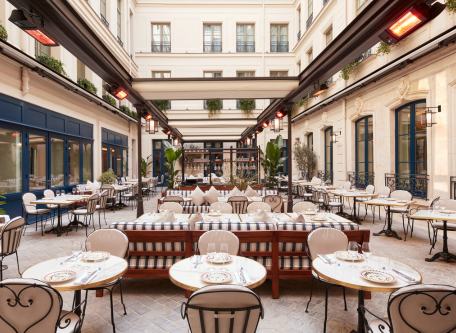Receive for Free - Discover & Explore eNewsletter monthly with advance notice of special offers, packages, and insider savings from 10% - 30% off Best Available Rates at selected hotels.
history
Discover the Maison Delano Paris, which was once a private mansion owned by renowned French art collector Augustin Blondel de Gagny.
Maison Delano Paris, a member of Historic Hotels Worldwide since 2023, dates back to the 18th century.
By the beginning of the 18th century, Paris had long been one of Europe’s foremost cultural centers. The study of architecture was particularly popular in the city, as architects spent years building countless structures with various experimental styles. Driving this intellectual pursuit in the 1700s were a growing number of government officials and tradespeople who had begun to constitute the upper echelons of Parisian society. They namely set about funding the creation of uniquely designed homes in order to showcase their newfound wealth. Known as “hôtel particuliers,” those structures were freestanding edifices built around a massive central block called a “corps de logis.” Flanking the central block were usually two wings that formed an intimate courtyard replete with gorgeously landscaped gardens. But despite the name, the manors did not act like any kind of commercial lodging. On the contrary, the term merely referred to their ability to host personal guests inside semi-independent private apartments. Nevertheless, one region of Paris that saw heavy construction of hôtel particuliers was the area surrounding the Faubourg Saint-Honoré. Among the dozens of hôtel particuliers built was the future Maison Delano Paris, which opened along a small avenue adjacent to the Faubourg Saint-Honoré called the “Rue d’Anjou.” While the precise date for its debut is unknown, historical records do indicate that someone named Elisabeth Bidaud de Salnove lived on-site as early as 1720.
Then, in 1723, Augustin Blondel de Gagny purchased the home for use as his own residence. An aristocratic art collector, Gagny quickly set about transforming the quaint manor to reflect his own eclectic tastes. To that end, he hired the renowned architect Pierre Contant d’Ivry to thoroughly reconstruct the entire building. Thanks to their combined efforts, the mansion was gradually reconstructed over the following decade to display some of the finest Rococo-inspired architectural motifs in the neighborhood. Gagny subsequently lived inside the magnificent hôtel particulier for years, during which time he became a respected treasurer and cultural advisor to King Louis XVI. In fact, he had even managed to establish himself as the main event organizer for the French court—an enviable position that facilitated close personal connections to the royal family. But Gagny had started to spend less time at the building, first renting out portions to another aristocrat before finally vacating it completely for his deceased father’s mansion near the Tuileries Gardens in 1758. The home then passed among various other Parisians throughout the next two centuries, including General Claude-Anne Le Texier and Lord Charles-Simon Millet. One of the last was 19th-century politician René de la Tour du Pin Chambly, a committed monarchist who would earn praise fighting in the Crimean War, the Second Italian War of Independence, and the Franco-Prussian War.
Having functioned as an opulent residence for generations, the hôtel particulier was eventually turned into a brilliant boutique hotel during the 21st century. This transformation specifically occurred when a small hospitality company acquired the site and conducted an extensive renovation in 2013. However, the erstwhile mansion would undergo a second period of renovation after Accor and Katara Hospitality decided to further enhance its high-end luxury appeal eight years later. The hotel closed for several months while both teams worked diligently to reconfigure the interior floor plan to offer only the best in contemporary comfort. But Accor and Katara Hospitality also endeavored to revitalize the building’s historic architecture in recognition of its special heritage. Slated to be the flagship for Accor’s prestigious Delano brand, the hotel offers guests access to 56 wonderfully designed guestrooms and suites that brilliantly capture the elegant cultural environment of Paris. The building functions as an upscale culinary attraction, with Michelin star chef Dani García operating a spectacular French-Andalusian restaurant named “La Chambre Bleue” in the original courtyard. Truly few places in Paris are better for a memorable vacation than this fascinating historic destination.
-
About the Location +
Celebrated as the “City of Lights,” Paris is one of the most famous metropolises in the world. Its history harkens back centuries, beginning with the arrival of the Celtic Parisii nearly two millennia ago. The Parisii specifically settled around a small island within the Seine that would be called the “Île de la Cité.” Over time, the small Parisii community emerged as one of Europe’s major trading hubs, attracting merchants from places as far south as the Iberian Peninsula. Its prosperity eventually drew the attention of the Roman Empire, which had been invading the region amid a conflict remembered as the “Gallic Wars.” Once the Romans conquered the Parisii in the 1st century B.C., they immediately began to redevelop the site as a much larger settlement named the “Lutetia Parisiorum.” Great wealth flowed into the community, leading to a massive wave of construction that expanded its size exponentially. Dozens of magnificent structures soon dominated the local skyline, including theaters, temples, and public baths. Lutetia even entertained a sprawling forum, as well as a spacious amphitheater. Nevertheless, the city’s golden years came to an end when the Roman Empire collapsed throughout the 4th century A.D. Now known as “Parisius,” it soon fell prey to roving bands of hostile Huns and Vikings.
The ancient French then rose to challenge the marauders, with their leader Clovis establishing his seat of power in the city. But when Clovis’ descendants opted to relocate to Aachen decades later, the community once again struggled to protect itself. The raiders were ultimately turned back when a count named Odo defeated them during a siege of the city in the late 9th century. Referred to as “Paris” by this point, the location would only return to political and cultural relevance after the election of Hugh Capet as French monarch in 987. His own royal dynasty would rule over France from Paris over the next four centuries, with two cadet branches—the Valois and the Bourbons—succeeding it for another five. Paris flourished under the reinvigorated French monarchy as well, who sponsored numerous building projects. Indeed, they commissioned the dredging of the Seine for the creation of new neighborhoods and worked to produce a new massive marketplace (Les Halles) in the Île de la Cité. The Île de la Cité nonetheless remained the essential “heart” of the city, serving as the site of both the famous Notre-Dame Cathedral and the Palais de la Cité. Furthermore, Paris became protected by a massive fortress called the “Louvre,” which originally guarded against the English military during the Hundred Years War.
The French kings kept expanding the city for many centuries thereafter, developing important structures like the famed Pont Neuf, the Places des Vosges, and an extension of the Louvre called the “Tuileries Palace.” This cultural importance endured for generations, too, even after King Louis XIV moved his entire court to the Palace of Versailles just beyond the city limits. Indeed, Paris became a bastion for The Enlightenment, which inspired the creation of additional landmarks, including the Place Vendôme, the Places des Victories, and Les Invalides. However, all France had started to suffer from a prolonged economic crisis that fomented discontent toward the French crown. Paris was thus the epicenter for the French Revolution when it erupted in 1789. In fact, the monarchy was abolished in Paris at the height of the event, with the reigning king, Louis XVI, executed on the Place de la Concorde. After years of political instability, Napoleon Bonaparte—a successful revolutionary general from Corsica—then seized power as First Consul and then Emperor. While Napoleon fought a series of wars of conquest across Europe, he also fully restored Paris back to France’s capital. He specifically bestowed it with his royal patronage and constructed many new edifices, like the Arc de Triomphe, the Canal de l’Ourcq, and the Pont des Arts.
Paris continued to act as the official French capital in the wake of the French Revolution and Napoleonic Wars, during which time it began to take on much of its present appearance. The most impressive changes occurred during the reign of Napoleon Bonaparte’s nephew, Emperor Napoleon III, who had risen to power following the Revolutions of 1848. Selecting a French official named Georges-Eugène Haussmann, he commissioned a massive building project that sought to transform downtown Paris into what he considered to be a “modern” city. To achieve that goal, Haussman redeveloped entire districts in a unique architectural style known today as “Second Empire.” Paris subsequently remained France’s primary cultural center, even as it was beset by war during the late 19th and early 20th centuries. It subsequently hosted two magnificent international expositions—the 1889 Universal Exposition and the 1900 Universal Exposition—that further solidified Paris’ cultural standing among contemporary Europeans. (The Eiffel Tower itself debuted as the central attraction for one of those fairs.) Many intellectuals also moved to the metropolis at the time, making it the birthplace of innovative artistic movements as “Naturalism,” “Impressionism,” and “Cubism.” Paris still embraces its place in the world as a purveyor of culture today, hosting countless museums, art galleries, and theaters that attract thousands of visitors every year. Its historic downtown—centered around the Île de la Cité—has even been designated as one of the planet’s most prolific UNESCO World Heritage Sites.
-
About the Architecture +
When Augustin Blondel de Gagny originally oversaw the development of his personal hôtel particulier, he chose the then-conventional style of French Rococo for his inspiration. Also called “Late Baroque,” Rococo architecture first arose in popularity across Europe during the first half of the 18th century. It specifically appeared in pre-Revolutionary France as a reaction to the ponderous and overwhelming classicism of King Louis XIV’s brand of architecture, best epitomized by his famous Palace of Versailles. In response, several painters, engravers, and architects created their own equally impressive artistic style that sought to institute a more charming and intimate aesthetic into French society. At first, Rococo appeared at the private residences of affluent French merchants and middling aristocrats, before it quickly spread to other areas in Europe. Southern Germany itself was one of the major areas where Rococo became incredibly popular, with most of the work concentrated around Augsburg. Many also saw it as a secular challenge to monarchical power, as the architectural style was primarily embraced by the emerging middle classes of Europe. Nevertheless, Rococo borrowed heavily from the preexisting rocaille style and blended it with the ornate details of Italian Baroque. The new architectural form made wide use of elaborate, asymmetrical scrolling curves, designed in a way that typically mimicked either a “C” or an “S” shape. Other curvaceous figures included shells and rocks, so as to give a natural feel to the architecture. Entire rooms were also completely circular or elliptical in their layout, providing a sense of constant motion and drama within the space. Architects also relied upon a hue of pastel colors that instituted a combination of light and brightness to every room. Gold appeared in particular, employed to convey a sense of awe but not bewilderment. Grand pieces of artwork defined the interior, too, along with a wealth of sculpted molding and decorative gilding. Perhaps the single greatest type of art utilized was the “trompe-l’oeil.” The trompe-l’oeil was a fresco that used realistic imagery to create an optical illusion that made the depicted objects appear as if they were three-dimensional.


























